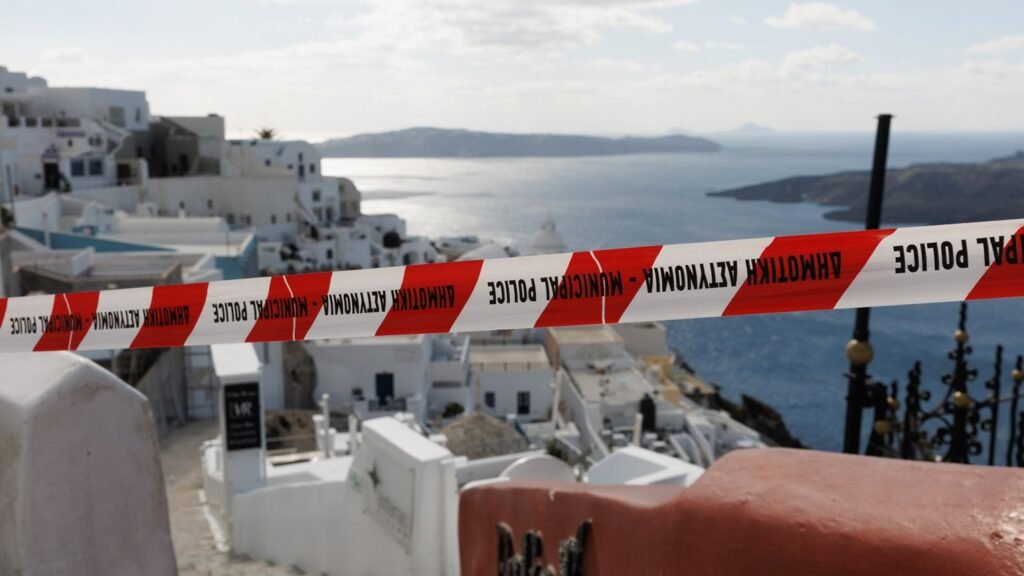Introduction
February is usually a quiet period on the Greek island of Santorini, a globally renowned tourist destination attracting over three million visitors annually. However, the island is now experiencing an eerie silence—not due to the off-season but because of relentless Santorini earthquakes that have driven thousands to flee. The tremors have disrupted daily life, instilled widespread fear, and raised significant concerns about the island’s long-term safety.
The Ongoing Seismic Swarm
Since January 25, thousands of tremors have rocked Santorini and its neighboring islands. The peak so far was a magnitude-5.2 earthquake northeast of the island, followed by a 5.3-magnitude quake days later. While most tremors have been minor, over 160 have exceeded magnitude 4—a drastic increase compared to the 90 recorded in all of the previous year. The unrelenting seismic activity has caused structural damage, prompting ongoing inspections and emergency reinforcements to critical infrastructure.
Geophysicists remain uncertain about what’s next. Vassilis Karastathis, director of the Institute of Geodynamics at the National Observatory of Athens, explained, “There are signs of stabilization, but we need a further drop in tremor frequency to be sure.” He warned that while a lot of seismic energy has already been released, a larger earthquake cannot be ruled out. Scientists continue to analyze data to determine whether this swarm is subsiding or building toward an even more significant event.
Fear and Mass Evacuations
The uncertainty has prompted a mass exodus. Of the 15,500 residents, at least 13,000 have left in the past week. Tourists are sparse, and businesses have paused operations. Hotels, which would normally be preparing for the upcoming tourist season, remain eerily vacant.
Giorgos Kalamatas, a wedding fireworks organizer, left with his family for Athens. “The constant shaking was nerve-racking,” he said. “We decided it was safer to leave, at least for now.” Many others share his sentiment, opting to relocate until authorities confirm the danger has passed.
For those who remain, life has been upended. Schools are closed, indoor gatherings are restricted, and emergency workers are on standby. Some residents have resorted to sleeping in their cars out of fear. Renia Bledaki, a makeup artist, chose to send her children to Athens but stayed behind to care for her elderly relatives. “We sleep in our cars, just in case,” she shared. With each passing day, those still on the island must decide whether to endure the uncertainty or leave their homes behind.
Government Response and Safety Measures

The Greek government has declared a state of emergency to fast-track aid distribution. Prime Minister Kyriakos Mitsotakis assured residents that all necessary precautions were being taken. “We’re preparing for the worst while hoping for the best,” he stated. Officials have acknowledged the seriousness of the crisis and are mobilizing resources to mitigate the risks.
Authorities have deployed seismic monitoring equipment, closed off landslide-prone areas, and reinforced vulnerable coastal homes with sandbags. Engineers are assessing damage to critical infrastructure, including ports and bridges, to ensure they can withstand further tremors. Psychologists from the Hellenic Red Cross have been counseling anxious residents, while local priests hold prayer services for relief from the tremors. Aid groups have also stepped in to provide temporary housing and food supplies for those displaced by the earthquakes.
Infrastructure and Tourism Concerns
Santorini’s stunning landscape, shaped by ancient volcanic activity, now faces renewed scrutiny over its structural integrity. Experts warn that parts of the island, particularly the cliffside areas of Fira and Oia, are at risk. The possibility of landslides or rockfalls remains a pressing concern as authorities assess the impact of the quakes on Santorini’s delicate geological formations.
Dimitrios Papanikolaou, a geology professor at the University of Athens, highlighted the danger: “The hardened lava and pumice stone foundations in these areas are flimsy. A stronger earthquake could cause balconies and pools to collapse.” Reports of cracks forming in some cliffside structures have heightened fears, leading to urgent discussions about strengthening building codes and reinforcing older structures to withstand future quakes.
Adding to the uncertainty, the environment ministry had already halted new construction projects last November, citing concerns over overdevelopment and stability risks. Now, the ongoing quakes have reignited debates over safety regulations and infrastructure reinforcements. Tourism officials are also grappling with the potential economic fallout, as prolonged seismic activity could deter travelers from booking trips to Santorini in the coming months.
What’s Next for Santorini?
Seismologists are still analyzing whether these tremors are a seismic swarm—a cluster of smaller quakes—or a precursor to a major earthquake. The fault line responsible differs from the one that caused Santorini’s devastating 7.7-magnitude quake in 1956, but concerns remain. The unpredictability of seismic activity in this region makes long-term planning difficult for residents and authorities alike.
While officials and scientists work to assess risks, residents and business owners face difficult decisions. Many, like Kalamatas, hope to return soon. Others, like Bledaki, question whether their homes will withstand another powerful quake. With key sectors of the island’s economy—such as tourism, real estate, and hospitality—directly impacted by the ongoing tremors, the uncertainty extends beyond physical safety and into financial security.
For now, Santorini remains on edge—its once-thriving streets eerily empty, its future uncertain. Residents are anxiously watching for updates from seismologists, hoping for reassurance but bracing for more disruption. Whether this period marks a temporary crisis or a long-term shift for the island remains unknown, but one thing is clear: Santorini’s resilience is being put to the test like never before.


